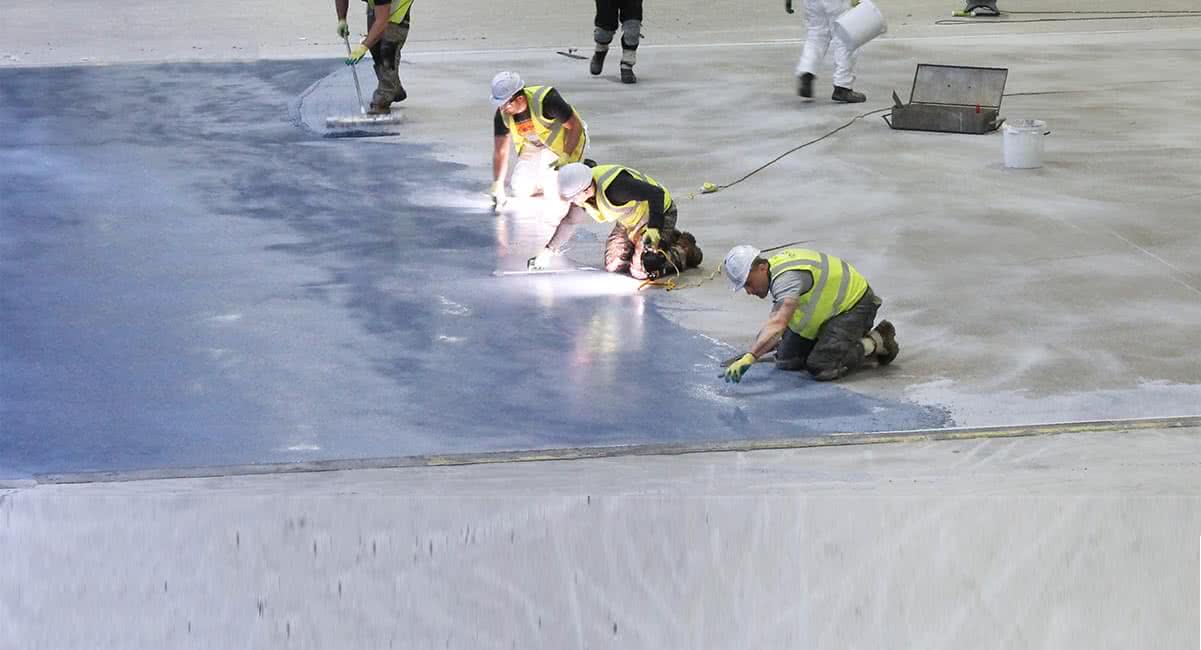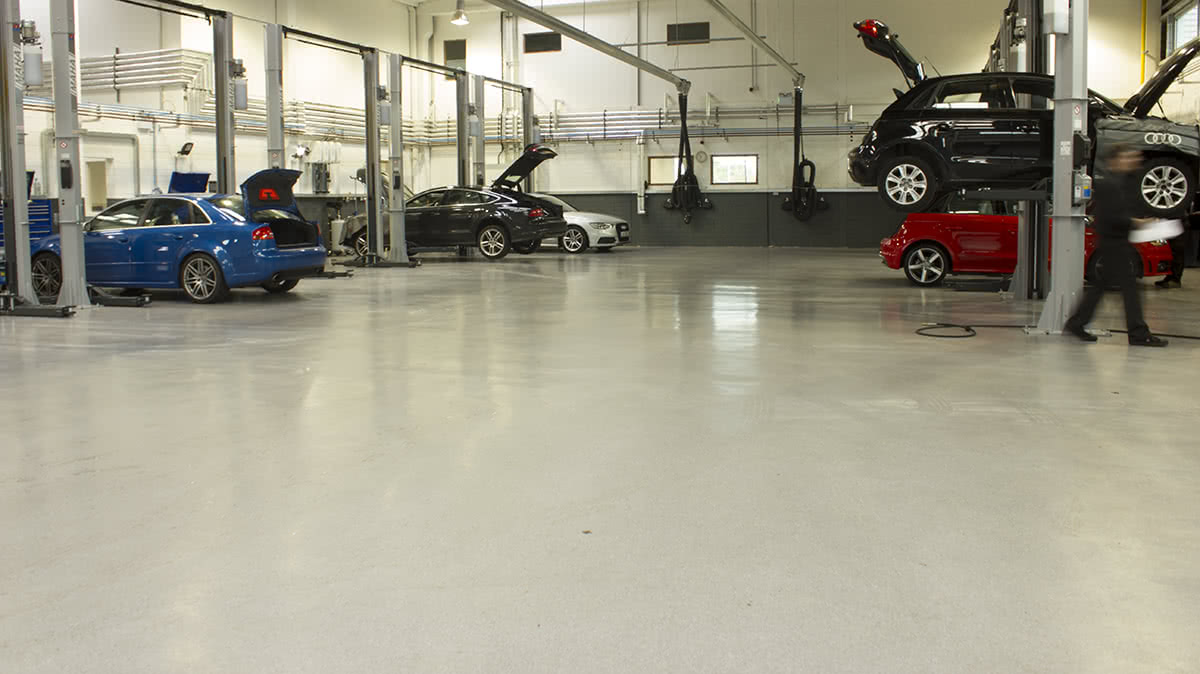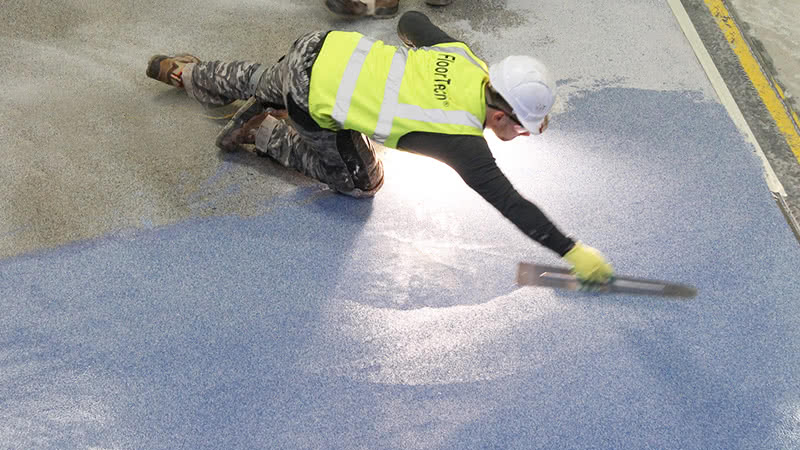Does your facility require anti-static flooring?

Selecting the right industrial flooring for your production facility can be challenging, especially where identifying the most appropriate finish is concerned. That’s because there are several finishes, colours and materials to choose from, not to mention specific performance requirements to consider. A finish that meets the UK’s rigorous hygiene requirements for healthcare, for example, may not also be the natural fit for delicate manufacturing processes.
One of those factors to consider, relevant to a wide range of industries, is whether flooring needs to incorporate an anti-static finish. Our guide will help you establish whether you need anti-static, what types are available, what benefits to expect, and what options to consider…
Anti-static flooring in a nutshell
Some industrial environments are prone to generating electrostatic discharge (or ESD), a pulse of static electricity that is passed from a person or surface to another object. Although this static electricity conduction is not always apparent, in some cases it can be sufficient to generate a spark or tiny blue bolt of electricity.
At the harmless end of the scale, an electrostatic shock manifests itself as a mildly uncomfortable or surprising shock. In the presence of flammable chemicals, materials or gases, however, an electrostatic spark can be highly dangerous and potentially even catastrophic. In those cases, installing anti-static flooring is an essential step in creating a safe environment for workers and visitors, since (as the name suggests) anti-static industrial floors insulate the environment against this electrostatic charge.

Where Anti-Static flooring is essential
According to UK Health and Safety regulations, anti-static flooring is mandatory in certain industries as the most basic safety precaution. Chemical manufacturers and processors, as well as any businesses that use flammable chemicals or materials in their operations, need to create static-free work environments to avoid igniting chemicals, fumes or even microscopic flammable particles.
Since electrostatic discharge can render sensitive electronic components useless, organisations that produce or assemble semiconductors or electronic goods need anti-static floors to mitigate the risk of electromagnetic charge accumulation.
Additionally, any operations that rely on uninterrupted or guaranteed use of specialised electronic items, such as hospitals or air-traffic control rooms, should take precautions to avoid static. Other examples of UK industries that require anti-static flooring include munitions or pyrotechnics manufacturers, military operations, micromechanics, optical lenses, photographic film, lasers, biotechnology, pharmaceuticals, surgical implant manufacturing, medical environments and even some food and beverage production environments.
How Anti-Static flooring works
Anti-static floors work by taking the static electricity that builds up naturally in any environment and transferring it through the floor to ground. By grounding the charge, anti-static flooring prevents the ESD from building up and discharging into the environment, where it could be destructive to goods or dangerous to people.
Paradoxically, almost any movement creates static electricity, no matter the environment or activity. Office workers will have experienced the build-up of static from walking across the carpet, while those operating vehicles, heavy equipment or machinery over a warehouse floor will be aware of the static charge these generate.
The majority of electrostatic discharges are below 3,500 volts and totally undetectable to people, so we’re not even aware of most of the potentially dangerous ESD happening all around us. Anti-static flooring, however, is capable of capturing all those charges and grounding them before they cause reactions.
Choosing an Anti-Static Floor
Anti-static flooring covers many uses, and as a result, there are many factors to consider when choosing which type of anti-static floor to install.
The first step is to understand the risks and requirements for your specific use case, including how electrostatic energy is generated in your location, the estimated strength of your average ESD and the potential consequences of electrostatic discharges in your facility.
Next, it’s important to understand the subtle but important differences in static control terminology to help you decide which type of anti-static flooring is right for you.
The resistance or impedance of anti-static flooring is expressed in ohms (Ω), a unit of measurement named after German physicist Georg Ohm, creator of Ohm’s Law, which governs electrical currents through conductors. Anti-static flooring options include conductive and dissipative systems, which offer different ranges of electrical resistance; in general, conductive flooring offers a resistance of up to 1 mega Ω, and static dissipative flooring provides resistance between 1 mega Ω and 100 mega Ω.
In simple terms, higher resistance equals lower conductivity of energy; however, that doesn’t mean that lower resistance is necessarily the better option for anti-static floors. In fact, in most “mission-critical” environments like emergency call centres or air traffic control towers, grounding standards recommend static dissipative flooring over conductive flooring options. Ultimately, the specific needs of your facility will govern which choice is right for you.

Tips on choosing an anti-static solution
Even the most elaborate, well-considered anti-static flooring solution will fall short of expectations without professional expertise during installation. A reputable provider can make a huge difference in the effectiveness and longevity of your floor. In this respect, beware of price as a deciding factor and choose a provider or contractor based on their experience, reputation and reliability.
Where industrial flooring is concerned, the Total Cost of Ownership is the most reliable benchmark, whether the flooring is anti-static, concrete, resin or carpet. This cost reflects not just the installation, but also the maintenance and repair (as well as the warranties that cover them). Do a thorough check of the company providing the solution, including their history and reputation; no reputable provider will bristle at you doing your due diligence.
The importance of maintenance
Your industrial flooring provider should be able to give you a transparent forecast of maintenance and repair costs for your anti-static flooring. Bear in mind that epoxy anti-static floors cannot be overlaid as this will insulate the floor from the earthing points so the epoxy must be first removed back to the substrate, with new copper strips installed for re-earthing and grounding. The new epoxy coating is then installed with an additional 7 days before the epoxy fully cures.
Vinyl flooring will have a shorter life expectancy and a lower abrasion resistance resulting in the need for maintenance and ultimately replacement in a far shorter period. By contrast, PMMA flooring can be reverse-cured, which makes spot repairs easy to do. Get to know the needs of the floor types you’re considering and factor the expected costs of maintenance and repairs into your budget to get a true picture of how much a solution will cost.
Start with the sub-floor
No anti-static flooring solution performs independently of the sub-floor conditions, so it is essential to assess the quality of the site before installation. Contaminated concrete or moisture problems can lead to ineffective and even problematic flooring. Most issues can be solved ahead of installation—provided you are aware of them. Flooring manufacturers and certified contractors will be able to arrange for your sub-floors to be tested ahead of installation to help ensure the success of your anti-static floors.
Advanced anti-static flooring from Trazcon
Today’s leading anti-static flooring solutions have applied innovation through simplicity. Trazcon anti-static dissipative flooring offers an electrical resistance of ×106Ω < RE < 1×108Ω, making it an ideal solution for a wide range of anti-static flooring needs. Whereas traditional anti-static flooring was made up of a primer, copper strips, independent wiring and an epoxy coating that took seven days to fully cure (harden), Trazcon anti-static contains an anti-static filler powder in the seal coat and boasts an industry-leading one-hour cure time. As a result, the floor is ready for use just one hour after installation, yet any subsequent repairs can be made without digging up large sections of the floor or cutting channels for regrounding. As Trazcon anti-static is a dissipative floor the need for copper strips or earthing points is eliminated.
Floortech is the specialist UK provider of the PMMA anti-static flooring solution, which is highly recommended for laboratories, production areas, material testing zones, service workshops, automotive facilities, and electronic component areas. Our Trazcon® Anti-Static system is suitable for use in AtEx zones, offering protection for the storage of flammable liquids, gases, vapours and mist, as well as combustible dust.
For specifics about PMMA anti-static flooring, download the technical data sheet available from Floortech or contact our team of experts.
Request a Quote
Please provide as much detail as possible about your specific needs & a member of our UK team will be in touch.
We do not install domestic flooring.